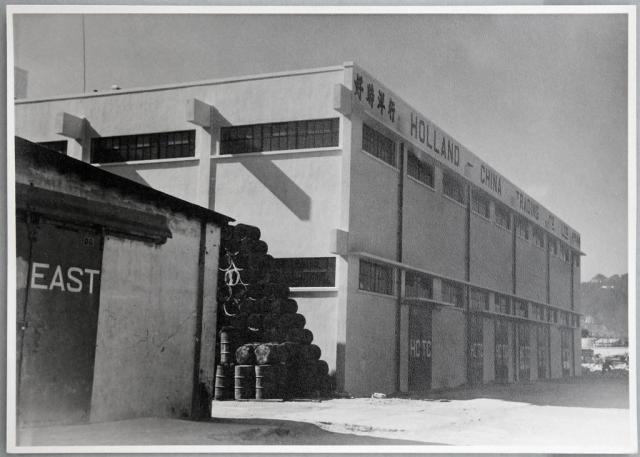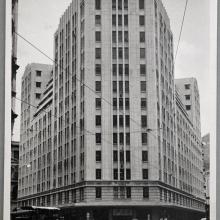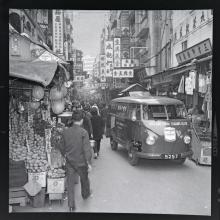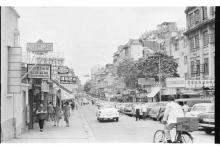Charles Gesner van der Voort had started his career in Rotterdam, at Holland-China Trading Company (HCHC). In 1938, he went to Shanghai for the firm. The Japanese interned him, and most other Dutch nationals, from 1943-45. In camp, he met his wife Nancy and they married after the war. After a leave in The Netherlands, they returned to the Orient, where Charles continued to work for HCHC in Hong Kong.
This photo was found in the company archives, held by Stadsarchief Rotterdam. A new warehouse was built at North Point, Hong Kong, in 1950. On the back of the photo, the building is referred to as "goedang", the Dutch way of writing the Indonesian word gudang, meaning warehouse. It is very similar to the word which was used in Shanghai when Charles worked there: godown.
Thanks to Gwulo.com member Herostratus, the address was found: 114-126 Wharf Road. An aerial photo from 1950 can be found here: <a href="https://old.gwulo.com/%3Ca%20href%3D"https://gwulo.com/atom/20399">https://gwulo.com/atom/20399" rel="noreferrer nofollow">gwulo.com/atom/20399</a>
HCHC had its offices in Alexandra Building.
<a href="https://old.gwulo.com/%3Ca%20href%3D"https://en.wikipedia.org/wiki/North_Point">https://en.wikipedia.org/wiki/North_Point" rel="noreferrer nofollow">en.wikipedia.org/wiki/North_Point</a>:
Parts of North Point have been inhabited since before the British arrived in the mid-19th century. The Metropole Hotel was built in 1899 and was used until 1906. In 1919, the Hongkong Electric Company started operation of the territory's second power station at North Point. In the 1920s, Ming Yuen Amusement Park became a popular entertainment venues on the Island. During the 1930s, the beaches of North Point became one of the most popular places for holding swimming gala in Hong Kong. In 1938, the North Point Refugee Camp was built to accommodate the influx of refugees from the Mainland. The camp comprised 26 huts. Access to the camp was via Kam Hong Road and Marble Road. During World War II, the camp was renamed the North Point Camp, and used as a prisoner of war camp for captured Canadian soldiers during the Japanese occupation.
During the Chinese Civil War, a large number of the rich and middle class from Shanghai fled to Hong Kong to escape the turmoil of war, many of them settled in North Point. In 1950, North Point became known as "Little Shanghai", since in the minds of many, it has already become the replacement for the surrendered Shanghai in China. The first wave of emigrants introduced Shanghai-style restaurants, beauty parlours and barbershops. They also learned Cantonese and intermarried with people of other dialect groups. During the 1950s, North Point was the premiere place of residence for these emigrants, leading to a massive population boom; by the end of 1960, North Point was listed as the most densely populated place on earth by the Guinness Book of Records. The first school in Hong Kong to use Mandarin as the main medium of instruction, Kiangsu and Chekiang Primary School, was founded in 1953 in North Point by these early Shanghainese immigrants. Shanghai at the time was heavily associated with leftist movements; leftist-supported businesses in North Point, such as the Sunbeam Theatre which showcases Chinese Opera, are a legacy of their influence.
The second group that moved to North Point were the Fujianese, who were mostly displaced by political events in Southeast Asia. Small Indonesian specialist grocery shops selling coffee, coconuts, and bumbu are some of the remaining traces of their identity. The area became known as "Little Fujian". And Chun Yeung Street which is one iconic place that you can easily find variety of traditional Fujianese food from the grocery shops, such as "misua", "tokwa", "tikoy", "lumpia" & "green bean cake".
1256 N.V. Internationale Crediet- en Handelsvereniging Rotterdam/C.V. en N.V. Wm H. Muller & Co. (Internatio-Muller N.V.) 1479 Foto's Holland China Trading Co in Sjanghai en Hong Kong.
courtesy Stadsarchief Rotterdam, <a href="https://old.gwulo.com/%3Ca%20href%3D"http://www.stadsarchief.rotterdam.nl/en">http://www.stadsarchief.rotterdam.nl/en" rel="noreferrer nofollow">www.stadsarchief.rotterdam.nl/en</a>





Comments
Please do you know the
Please do you know the address of this warehouse? I'd like to make a Place for it.
Location
The Location is today 114-126 Wharf Road. On the right hand side of the photo in the distance oil tanks near the north point power station can be seen. In the below photo the godown can just be made out in the centre of the picture behind the warehouses on the waterfront.
Holland-China Trading Company: Hong Kong warehouse, North Point,
Many thanks for the link to the aerial photo and the address Herostratus, I appreciate it!
Holland-China Trading Company: Hong Kong warehouse, North Point,
I've just found an address of the godown / warehouse in North Point: 431 Java Road. I guess the oil tanks of the power station could be seen from several perspectives.
Warehouse location
I think Herostratus's location is more likely, as the building he spotted on the aerial photo is a good match for the building at the top of the page. The doors on the front of the building have the same 1-4-1 pattern.
Please could you let us know the source of the 431 address?
Holland-China Trading Company: Hong Kong warehouse, North Point,
David,
Had overseen this reply, sorry for that. The address was found in the back of the HCHC photo album, which had an overview of small prints of the warehouse photos, with the address next to it. So I am convinced this is the address.
Kind regards,
Pieter
431 Java Road does not exist
431 Java Road does not exist as an address in Hong Kong. This location is actually 363 Java Road, the highest number that Java Road currently goes up to. While streets often got renumbered in Hong Kong, having gone through 20 years of old maps of the area, Java Road did not exist in this location until the mid 1960s, the area was wasteland or storage yards. None of the maps ever show a 431 Java Road anywhere. Another photo you posted confirms the location of the warehouse being on Wharf Road:
Holland-China Trading Company: Hong Kong warehouse, North Point, 1950, by Charles in Shanghai
The above photo is of a different building than the original picture. These godowns were right on the waterfront directly in front of the building in the original photo. On the roof of one of the buildings were the initials NPW. Behind in the distance can be seen Holts Wharf and TST, which line up as you would expect for a photo taken at Wharf Road.
Holland-China Trading Company: Hong Kong warehouse, North Point,
Dear Herostratus,
I am convinced by your comments. I misinterpreted the text next to the photos of the warehouse, in the album.
The text reads:
"Marine Lot 431, Java Road, North Point.
Goedang North Point in Hong Kong.
In gebruik genomen in 1950."
[Godown North Point in Hong Kong. Put into use in 1950]
You can find the album page underneath.
https://www.flickr.com/photos/161392673@N02/48045153717/
Kind regards,
Pieter
North Point Wharves
Have created a place for North Point Wharves. In the recently posted photo above, you may wish to delete the place reference to the HCTC godown and insert North Point Wharves instead.
Holland-China Trading Company: Hong Kong warehouse, North Point,
Thanks for that moddsey, appreciate it. Have made the change to the various photos.